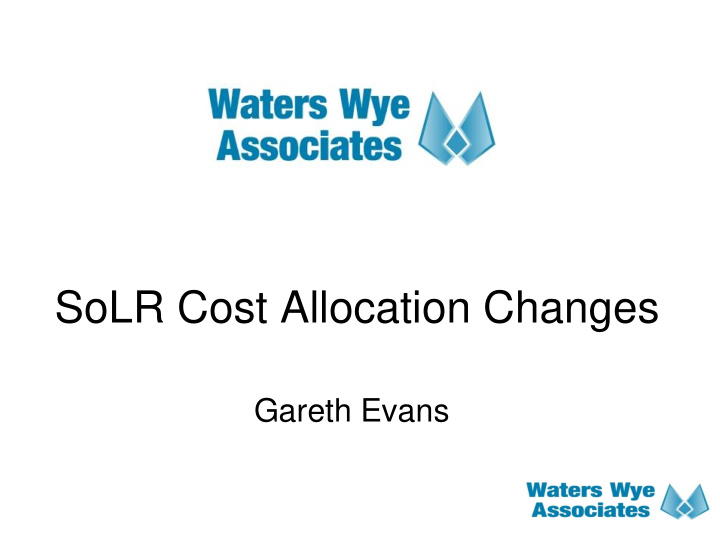



SoLR Cost Allocation Changes Gareth Evans
Purpose ➢ Purpose of presentation is to go through potential changes to how Supplier of Last Resort (SoLR) costs are recovered from shippers by Gas Transporters. ➢ Intention is to ensure gas market processes align with electricity market processes and to ensure equitable treatment across both fuels.
SoLR Events 2018/19 Date Company subject to SOLR awardee Costs claimed from industry SOLR Yes – £5.76m from gas, £7.72m November GB Energy Supply Co-Operative 2016 Energy electricity. Note this decision was made in March 2018. No – Ofgem did commit to covering January Future Energy Green Star 2018 costs from levy, but no claim has occurred. July 2018 National Gas and Hudson Energy Unknown, no specific reference in Power Limited decision. July 2018 Iresa Octopus Energy Yes - £5.92m gas, £7.24m electricity September GEN 4U Octopus Energy Unknown 2018 Yes. – First Utility committed to the October USIO First Utility 2018 lowest amount Yes – “partly by Scottish Power and November Extra Energy Scottish Power partly by industry levy”. 2018 Yes – “partly by OVO Energy and partly November Spark Energy OVO Energy by industry levy”. 2018 Yes – “partly by Together Energy and December OneSelect Together partly by industry levy”. 2018 Energy (Eddington Energy) January Economy Energy OVO Energy No - Ovo committed to paying credit 2019 balances in full. January Our Power Utilitia No - Utilitia committed to paying credit 2019 balances in full March 2019 Brilliant Energy SSE Yes.
Supplier Cost Recovery ➢ SoLR suppliers can make a claim for a Last Resort Supply Payment (LRSP). ➢ The LRSP is intended to cover the additional costs from an SoLR event over and above what it expects to recover from the SoLR customers. This can include credit balances. For most recent claims credit balances have been the largest item. ➢ Once an LRSP is approved by Ofgem, the gas transporters/DNOs then reimburse the SoLR supplier and recover the costs through transportation charges.
SoLR Cost Breakdown ➢ Octopus January 2019 (Both fuels) ➢ Co-Operative January 2018 (both fuels) ➢ Item 1: Recovery of 70% of GBES customers’ net credit balances (£10,979,815) ➢ Item 2: Emergency wholesale procurement (£1,269,801) ➢ Item 3: Cost of capital to fund credit balances (£1,790,167) ➢ Item 4: IT migration costs (£859,300)
Transporter Cost Recovery ➢ Licence Condition 48 covers Last Resort Supply Claims for Gas Transporters with transportation charges increasing to reflect the costs once the claim is approved. ➢ These costs will be added to the allowed revenue that each Gas Transporter is allowed to recover. ➢ The licence does not differentiate between market sectors. ➢ There is no specific provision for the treatment of these costs in the UNC or charging methodologies.
Electricity Cost Recovery ➢ Licence Condition 38 of the electricity distribution licence has the similar intent to the gas transporter licence condition 48. ➢ There is some uncertainty on how the Use of System Charges can be apportioned and so a number of DCUSA changes have been raised to ensure a consistent treatment of such costs. ➢ The one of relevance for how costs are allocated is DCP 332 (Appropriate treatment and allocation of Last Resort Supply Payment claim costs)
DCP 332 ➢ Four options on how costs are apportioned: ➢ Option A: Uniform uplift across all customer unit rate after tariff costs calculated. ➢ Option B: As A, but only for domestic customers ➢ Option C: Adjustment to fixed unit rate for all customers ➢ Option D: Adjustment to fixed unit rate for domestic customers Modification makes repeated reference to the need to link the benefits of the SoLR process for the customers expected to pay for it (domestic “safety net”).
Summary of Issue ➢ Majority of SoLR costs are credit balances. ➢ Non-domestic customers' credit balances are specifically excluded from the LRSP process. ➢ Domestic customers are specifically included. ➢ Cost recovery in electricity recognises this fact with the option of DNOs allocating costs to domestic sector only being considered. ➢ Cost recovery in gas does not recognise this fact with non-domestic customers contributing towards SoLR events in same proportion as domestic customers.
Possible Solutions ➢ SoLR costs should be allocated to the market sector they originate from. ➢ LRSP costs for non-domestic customers are recovered from the non-domestic sector, and likewise domestic. ➢ Precedent in electricity and also in gas (AUGE process, theft incentive scheme). ➢ Gas Transportation Charging does not have a specific domestic/non-domestic split like electricity. ➢ Any solution needs to take into account the current charging framework regime against improved cost targeting.
Possible Solution 1 ➢ Creation of new SoLR cost recovery charge. ➢ New charging item in transportation statement where all costs from LRSP payments are sub-divided by number of customers in the market sector. ➢ Expect (hope?) that this would be zero for most charging years. ➢ Sites identified via market sector flag held by Xoserve. ➢ Under/over recovery of any costs? ➢ Definition of cost splits. Is the information sufficient? Allows accurate cost targeting but requires new processes
Possible Solution 2 ➢ Option 2a: ➢ Uplift to the LDZ Capacity or LDZ Commodity for the approximate consumption thresholds: ➢ 0- 73.2MWh for “domestic” ➢ Higher consumption thresholds for “non - domestic” ➢ Option 2b: ➢ Uplift to the Customer (Capacity) for the approximate consumption thresholds: ➢ 0- 73.2MWh for “domestic” ➢ Higher consumption thresholds for “non -domestic ” Easier to implement but less accurate in cost targeting
Possible Solution 2 ➢ Option 2a: ➢ Uplift to the LDZ Capacity or LDZ Commodity for the approximate consumption thresholds: ➢ 0- 73.2MWh for “domestic” ➢ Higher consumption thresholds for “non - domestic” ➢ Option 2b: ➢ Uplift to the Customer (Capacity) for the approximate consumption thresholds: ➢ 0- 73.2MWh for “domestic” ➢ Higher consumption thresholds for “non -domestic ” Easier to implement but less accurate in cost targeting
Questions?
Contact Details Happy to answer questions : Waters Wye Associates: Gareth Evans:01473 822503 07500 964447 gareth@waterswye.co.uk
Recommend
More recommend